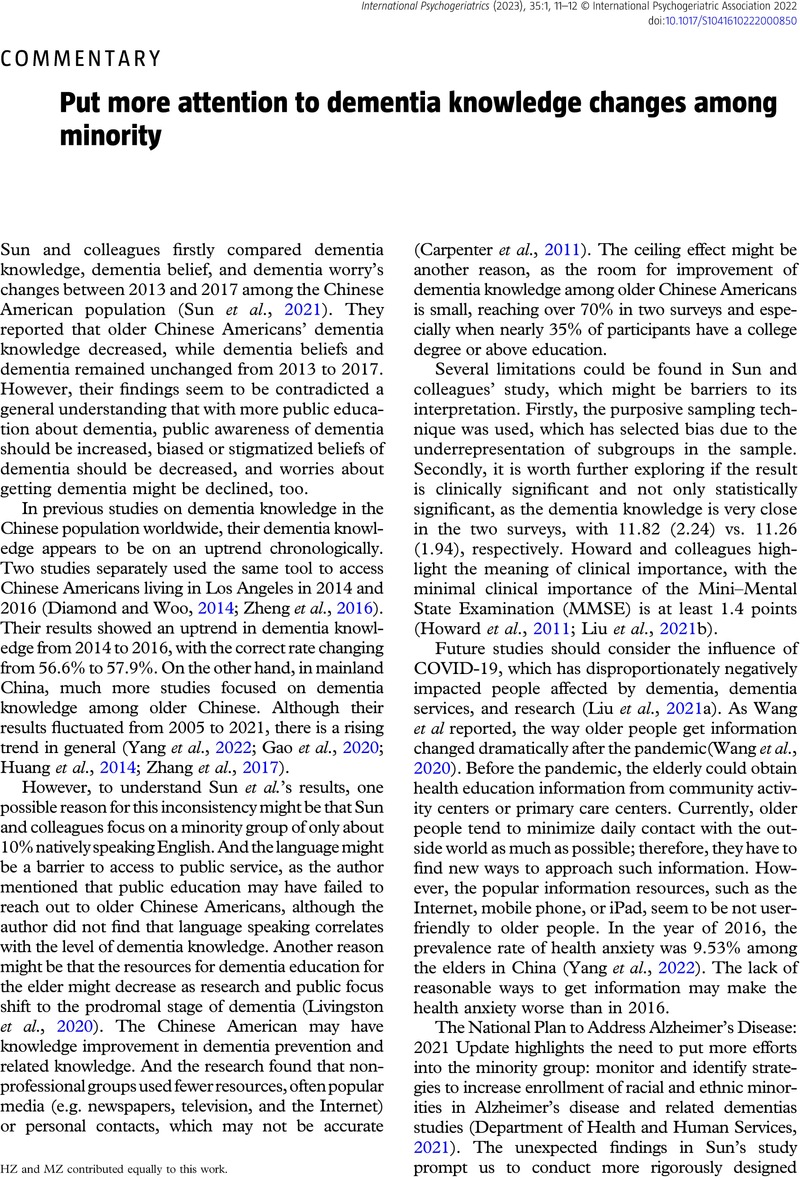No CrossRef data available.
Article contents
Put more attention to dementia knowledge changes among minority
Published online by Cambridge University Press: 21 September 2022
Abstract
An abstract is not available for this content so a preview has been provided. Please use the Get access link above for information on how to access this content.

- Type
- Commentary
- Information
- International Psychogeriatrics , Volume 35 , Special Issue 1: Issue Theme: Ageism, Dementia, and Culture , January 2023 , pp. 11 - 12
- Copyright
- © International Psychogeriatric Association 2022
Footnotes
HZ and MZ contributed equally to this work.
References
Carpenter, B. D., Zoller, S. M., Balsis, S., Otilingam, P. G. and Gatz, M. (2011). Demographic and contextual factors related to knowledge about Alzheimer’s disease. American Journal of Alzheimer’s Disease & Other Dementiasr, 26, 121–126.CrossRefGoogle ScholarPubMed
Department of Health and Human Services (2021). National Plan to Address Alzheimer’s Disease: 2021 Update,Google Scholar
Diamond, A. G. and Woo, B. K. (2014). Duration of residence and dementia literacy among Chinese Americans. International Journal of Social Psychiatry, 60, 406–409.CrossRefGoogle ScholarPubMed
Gao, M. X., Gao, M. X., Guo, L., Sun, F. and Zhang, A. (2020). Perceived threat of Alzheimer's disease and related dementias in Chinese older adults: The role of knowledge and perceived stigma. The International Journal of Geriatric Psychiatry, 35, 223–229.CrossRefGoogle ScholarPubMed
Howard, R. et al. (2011). Determining the minimum clinically important differences for outcomes in the DOMINO trial. International Journal of Geriatric Psychiatry, 26, 812–817.CrossRefGoogle ScholarPubMed
Huang, L., Zou, W. and Xiang, J. (2014). Investigation of the awareness rate about senile dementia related knowledge in population above 55-years-old in Changsha. Journal of Psychiatry, 6, 446–448.Google Scholar
Liu, K. Y. et al. (2021a). Dementia wellbeing and COVID-19: review and expert consensus on current research and knowledge gaps. International Journal of Geriatric Psychiatry, 36, 1597–1639.CrossRefGoogle ScholarPubMed
Liu, K. Y., Schneider, L. S. and Howard, R. (2021b). The need to show minimum clinically important differences in Alzheimer’s disease trials. The Lancet Psychiatry, 8, 1013–1016.CrossRefGoogle ScholarPubMed
Livingston, G. et al. (2020). Dementia prevention, intervention, and care: 2020 report of the Lancet Commission. The Lancet, 396, 413–446.CrossRefGoogle ScholarPubMed
Sun, F., Wang, K., Shen, Y., Gao, X. and Prieto, L. R. (2021). Dementia literacy and worry among older Chinese Americans in Arizona: a comparison between 2013 and 2017. International Psychogeriatrics, First view, 1–11. https://doi.org/10.1017/S1041610221001289
Google ScholarPubMed
Wang, H., Li, T., Barbarino, P., Gauthier, S. and Yu, X. (2020). Dementia care during COVID-19. The Lancet, 395, 1190–1191.CrossRefGoogle ScholarPubMed
Yang, G. et al. (2022). Prevalence and relative factors of health anxiety of elders in community healthcare centers. International Psychogeriatrics, 34, 735–742.CrossRefGoogle ScholarPubMed
Zhang, H., et al. (2017). Dementia literacy among community-dwelling older adults in Urban China: a cross-sectional study. Front Public Health, 5, 124.CrossRefGoogle ScholarPubMed
Zhang, M. et al. (2022). Excessive sleep increased the risk of incidence of cognitive impairment among older Chinese adults: a cohort study based on the Chinese Longitudinal Healthy Longevity Survey (CLHLS). International Psychogeriatrics, 34, 725–734.CrossRefGoogle ScholarPubMed
Zheng, X., Woo, B., Ofpacific, C., Sciences, W. U.o H., Center, V. and California, U. O. (2016). Association between recognizing dementia as a mental illness and dementia knowledge among elderly Chinese Americans. World Journal of Psychiatry, 6, 233.CrossRefGoogle ScholarPubMed


